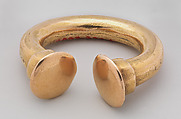Nose Ornament
Not on view
This object, like Metropolitan Museum of Art 2002.322.5, is a metal nose ornament that was fabricated by Zenú people, who lived and live today in the Caribbean Lowlands of Colombia. It consists of gold or likely a gold-copper alloy. Zenú metalworkers fabricated it primarily by lost-wax casting. (For more information on this process, please see 2008.569.13a, b). The object consists of a curved bar with a circular cross-section, with two capped ends. Zenú ceramic figurines show people wearing such an ornament with the two ends pointing downward, in at least three cases by passing the ornament through the septum of the nose (Museo del Oro, Bogotá CS4272, CS4197, CS4195) and in at least one case apparently by balancing the ornament over the nose (Museo del Oro, Bogotá CS4270). Falchetti (1976, 81) notes that a ceramic funerary urn from the area of the Tapias River shows a person wearing a similar nose ornament, but with the “opening turning to one side.” Other ceramic figurines of the Montelíbano Complex (see Falchetti 1995, pl. 57a,b) show people wearing these ornaments through the septum, with the ends downward, but also wearing them with other nose ornaments in the shape of half-moons. Jorge Robledo, a 16th-century Spanish colonist, reported seeing people wearing these nose ornaments, around Anserma, located in the Caldas department of Colombia (Falchetti 1976, 81).
The curved bar and what now appear as the capped ends were cast together. There is residue of the ceramic investment in the narrow space between the caps and the curved bar, which would have been difficult to access when the object was cleaned of the investment after casting. The shallow depressions on some parts of the caps suggest that metalworkers hammered these flaring ends once most of the investment was removed. The tears seen on the caps near their open ends may relate to the stress induced by hammering. There are also some punch marks on the exterior face of the curved bar, relatively close to one of the capped ends, suggesting that the metalworkers sought to finish the shape of the bar by hammering. After casting and likely after excavation, the opposite faces of the caps were heavily polished giving them the smooth surface visible today.
Interestingly, there is a thin line visible on the curved bar, following the shape of the curve, and located at the center of the bar’s width. On close inspection, there is a slight discontinuity where this line is located; the metal along this line has the appearance of a solder. One possibility is that the object was actually cast in two halves and then soldered to join these halves. Any discontinuity in the region of the capped ends may have been masked when these ends were hammered. An alternative is that the join relates to a repair. At least two nose ornaments of this same form from the Ayapel context show a similar line along the curved bar (University of Pennsylvania Museum of Archaeology and Anthropology, Philadelphia, PA, SA2721).
This ornament belongs to the group defined by Ana María Falchetti (1995, 152, fig. 71a) as “nose ornaments in the shape of an ‘n’” (“narigueras en forma de ‘n’”) and specifically Type 1a. Objects of this type show relatively high gold content and capped ends that curve inwards. There are variations within the larger group; in some cases, the ends are not capped, while in other cases, the ends have a braided design or several bands of metal (see Falchetti 1976, fig. 17; Falchetti 1995, fig. 71). The 55 objects of this type that Falchetti (1995, table 16) reports have a wide geographic distribution and are especially found in the areas of the Sinú, San Jorge, lower Cauca, and Nechí Rivers. A large group (16) was part of the aforementioned context excavated near Ayapel, between the San Jorge and Cauca Rivers. The sizes of these 16 ornaments are variable, their weights ranging from 4.8 g to 64.5 g according to the records of the University of Pennsylvania Museum of Archaeology and Anthropology, Philadelphia, PA. For further information on the context of Zenú metalwork, please see 1979.206.542.
Bryan Cockrell, Curatorial Fellow, Arts of Africa, Oceania, and the Americas, 2017
Related objects: 1979.206.534, 1979.206.542, 1979.206.543, 1979.206.544, 2002.322.5
Further Reading
Falchetti, Ana María. The Goldwork of the Sinu Region, Northern Colombia. MPhil diss., University of London, 1976.
———. El oro del Gran Zenú. Bogotá: Banco de la República, 1995.
Due to rights restrictions, this image cannot be enlarged, viewed at full screen, or downloaded.

